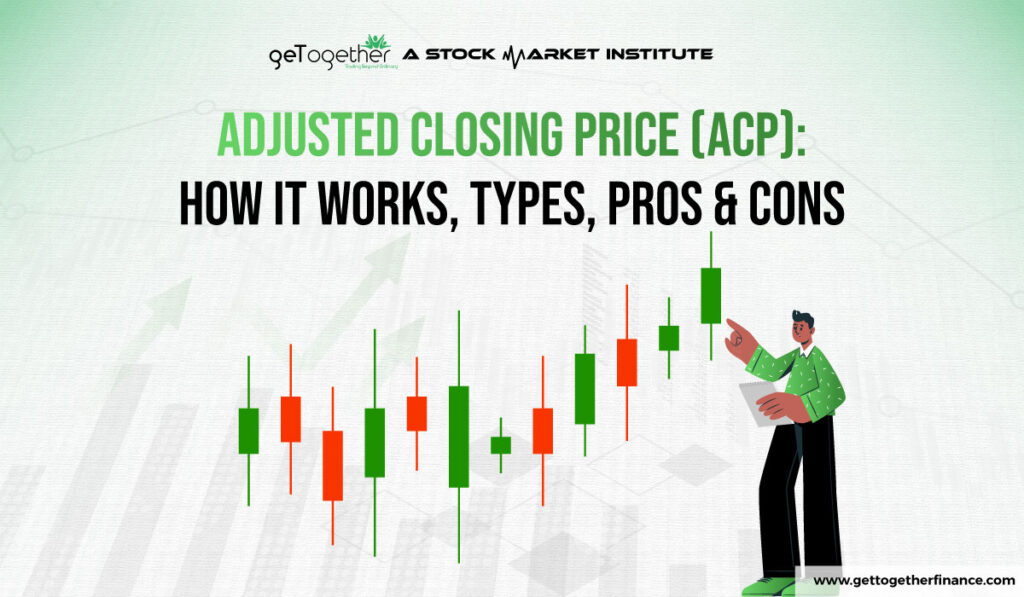Adjusted Closing Price (ACP): How It Works, Types, Pros & Cons


Introduction
The adjusted closing price is a stock’s closing price adjusted or modified to reflect any corporate action. These actions can be dividends, stock splits, bonus issues, etc. This adjustment is done to ensure that the private price movement of the stock is consistent, making it easier for traders and investors to track the stock on candlestick charts. For instance, if a company issues a dividend or splits its stock, the adjusted closing price takes these into account, offering the actual value of its stock.
Knowledge of adjusted closing prices is important for investors. It provides a more accurate view of the stock’s historical performance, making it easier to analyze returns. The use of flexible pricing allows investors to avoid tampered information derived from non-supply data, resulting in more informed investment decisions. This thorough technical analysis helps enormously in trend research, forecasting, and developing effective investing plans.
How Adjusted Closing Price Works

The adjusted closing price is a stock’s closing price which is adjusted for any corporate actions such as dividends, splits, and others to accurately align with its historical value.
Calculation of Adjusted Closing Price
The adjusted closing price is calculated by taking the closing price of the stock and adjusting it against any corporate action that has occurred. This can include stock splits, dividends, or new stock issues. For example, when a company pays a dividend, the stock price usually falls equivalent to the amount of the dividend on the ex-date. ACP of the stock compensates for the decline in the stock and ensures that the previous rates represent the value investors received from the dividend. Similarly, if a company splits its stock and the number of shares increases, while the price per share decreases accordingly, this closing price is based on this to ensure consistency. This change is necessary for an accurate assessment of performance over time.
Also Read: Price Elasticity of Demand
Factors Affecting Adjusted Closing Price
- Stock Splits: When a company decides to go for stock splits, the price per share declines, while the number of shares increases in the portfolio of current investors. For example, in a 2:1 stock split, each existing share is split in two, halving the current price. The adjusted closing price imitates this change by modifying the past prices of stock to ensure an accurate comparison and ease the analysis for future and current traders.
- Dividends: Cash or stock dividends impact the stock price. Cash dividends reduce the stock price by the amount of the dividend on the ex-date of the dividend. The adjusted price accounts for this change or decline in price. Stock dividends increased the number of shares used, decreasing the price per share proportionally.
- New Share Issues: If a company issues new shares, it can dilute the value of existing shares. The adjusted closing price in this scenario is modified to show this dilution. Again, it ensures that the historical price provides a true representation of the stock’s current value.
- Mergers and Acquisitions: When companies merge or one acquires another, the stock prices are significantly affected. Here, the adjusted closing price accounts for the changes to provide a traceable historical record.
By incorporating these changes, the adjusted closing price provides a more accurate representation of a stock’s worth over time, allowing investors to make more informed comparisons and analysis
Pros of Adjusted Closing Price

- Accurate Representation of Value
- The ACP reflects the fair and true value of the stock by incorporating the values of corporate actions like dividends, stock splits, and other corporate actions.
- The accurate valuation helps in mitigating misleading interpretations based on raw closing price.
- Better Comparison Across Time Periods
- ACP leverages investors with the correct information to compare a stock’s performance over different time periods accurately.
- The ensured consistency is crucial for long-term investment analysis, allowing unfiltered price data.
- Enhanced Investment Analysis
- ACP gives investors a detailed and precise analysis of stock’s over-time performance.
- Investors with this information can make informed decisions based on a comprehensive understanding of the price movement of the stock.
- Facilitates Technical Analysis
- ACPs are highly crucial in technical analysis, as they provide a true representation of previous movements on the charts.
- This aids in developing and implementing trading strategies based on filtered data.
Overall, the adjusted closing price is a useful tool for investors, providing a more accurate and trustworthy foundation for analyzing stock performance and making sound investment decisions.
Cons of Adjusted Closing Price

- Complexity in Calculation
- Calculating the ACP involves understanding and applying the data of various corporate actions.
- The process can be complex and time-consuming, requiring detailed knowledge and accurate data.
- Potential for Misinterpretation
- If the investors do not accurately interpret the adjustments, they may misinterpret the data, leading to adverse trading decisions.
- It requires a good grasp of technical analysis and experience in the market to interpret the changes and know the adjustments to avoid potential pitfalls.
- Dependence on Reliable Data
- The adjusted closing prices are entirely dependent on the data available for the corporate actions.
- Incomplete or incorrect data can lead to inaccurate adjustments, misleading traders and investors, and leading to unimaginable false alarms on technical charts.
- Adjustments Can Be Confusing
- Frequent adjustments, especially in stocks with good trading volume and many corporate actions can be highly confusing for traders and investors. Particularly for the ones who are new to the market.
- Investors need to be diligent in understanding each adjustment to avoid confusion and misinterpretation.
- Not Reflecting Market Sentiment
- As studied earlier, ACP clearly focused on historical data adjustments, it oversees the investor sentiments after the corporate actions.
- This is a huge limitation when trying to gauge the stock’/s present value or future potential based solely on historical performance.
Example of Adjusted Closing Price

Let’s consider a hypothetical example for certain stocks, listed on NSE.
Company: ABC Ltd.
Stock Split:
- ABC Ltd, announces a 2:1 stock split on June 3rd, 2023. This implies that each existing share is going to split into two shares.
- Before the split, the price of the stock was Rs200 on May 31st, 2023
Calculation of Adjusted Closing Price for May 31, 2023:
- Stock Split Adjustment:
- Since the stock split is 2-is-to-1, the number of shares is to be doubled while the price has to be halved.
- Adjusted closing price for May 31, 2023 = ₹200 / 2 = ₹100.
Dividend Payment:
- On August 1, 2023, ABC Ltd. pays its investors a dividend of Rs10 per share
- The closing price of ABC Ltd. on July 31, 2023, was ₹120.
Calculation of Adjusted Closing Price for July 31, 2023:
- Dividend Adjustment:
- The stock price typically falls by the price of the dividend on the ex-date.
- The adjusted closing price for July 31, 2023, should be = ₹120 – ₹10 = ₹110.
Summary
- Pre-Split Price (May 31, 2023): ₹200 → Adjusted Price: ₹100 (after 2-for-1 split).
- Pre-Dividend Price (July 31, 2023): ₹120 → Adjusted Price: ₹110 (after ₹10 dividend).
Adjusting previous prices provides investors with a more accurate picture of the stock’s underlying value and performance over time, making it easier to analyze and compare to other equities.
At Last
The adjusted closing price is a valuable tool for investors and traders since it accurately reflects a stock’s worth by taking into account business events such as dividends, stock splits, and mergers. This correction enables for more precise historical comparisons, which improves investment analysis and technical tactics. While calculating adjusted closing prices can be complicated and needs solid data, the advantages of maintaining a consistent and accurate historical record far exceed the difficulties. Investors who understand and apply modified closing prices can make more informed judgements, avoid misleading interpretations, and achieve better investing results. By accounting for business actions, the adjusted closing price keeps historical stock data understandable and relevant, facilitating long-term trend analysis and successful investment planning.
Frequently Asked Questions
What is the purpose of adjusted closing price in stock market analysis?
Adjusted closing prices account for business events such as dividends and stock splits, ensuring that historical stock data appropriately reflects long-term worth and performance. It facilitates reliable investment analysis and comparisons.
How is the adjusted closing price calculated?
ACP is calculated by changing the company’s closing price to account for the effects of corporate actions such as dividends, stock splits, bonus issuance, and mergers. Each change is performed to ensure the integrity and accuracy of past price data.
Why is knowledge of adjusted closing prices important for investors?
Understanding ACP allows investors to avoid drawing incorrect inferences based on raw price data. It provides a clearer picture of a stock’s performance, allowing for better investment decisions and strategic planning.
What are the potential challenges of using adjusted closing prices?
Challenges include the complexity of making adjustments, the reliance on accurate and complete data about company actions, and the risk of misinterpretation if adjustments are not well understood.
Can adjusted closing price be used for technical analysis?
Yes, ACP are important for technical analysis since they more accurately reflect historical price movements. This helps to build and implement effective trading strategies based on dependable data.



 Instagram
Instagram 
